In Part I of this series, we talked about my professional inspirations and how they can inform the layout of SparkFun's new Rapid Prototyping Lab. In this second and (maybe) final entry, we'll talk about the layout of a flexible workspace and the process of shopping for furniture and tools.
When I started this project, I asked for SparkFun to set aside $5k for a communal workspace. It would be my primary work area for product demos but it would also be open to anyone here who needed a place to work on SparkFun-related stuff. My budget request was graciously approved and I moved on to devising a floorplan. Creating a floorplan will help you avoid outgrowing your space as well as divide your shopping list into categories: fixtures, bench tools, hand tools, materials handling, storage, etc.
In order to lay out my floorplan, I had to pick the major fixtures like shelving and workbenches. I didn't necessarily need to pick a brand or a source, just find a standard size to use as a template. If you recall the previous post, you'll remember that we decided on two benches. One where some bench tools can live and a second for pure, clean workspace. Because we often end up shooting video in my workspace, I thought it would be nice to use the kitchen set from a cooking show as my model. A large counter behind the presenter makes a good place for things like stand mixers or ovens and a smaller island in front of the presenter serves as a cutting board and a range top. I sized out a larger (96"x36") and a smaller (48"x30") workbench and began to make a (roughly) scale drawing.
Between the two standing height benches I planned out space for an anti-fatigue floor mat. This keeps my feet and back from killing me for standing up all day and also formalizes the area of the workspace. For those times when I absolutely need to sit down and work, I planned to pick up a drafting stool. Some accommodation had to be made for my computer, so a space on the bench was marked off for that. Finally, I knew that I wanted some kind of wire shelving and some wheelie-carts for storage and flexible work space, so I took a stab at some measurements and draw everything up in a Google Doc:
As you can see, I labeled all of the fixtures not only with what they are but also the function they serve in the shop. There's a bench for electrical work and there's a bench for auxiliary use. There are individual wheelie-carts for 3D printing and model fabrication. Part bins and project bins are on separate shelving units. Since there were a number of benches and carts planned, and because this is supposed to serve more than one person at a time, I decided to throw in a few more chairs.
Now that I had a place for everything, I needed some everything to put in those places. Let the shopping begin! There are a couple of approaches to finding suppliers. If you have particular brands that you're fond of when it comes to particular items, you can hunt down their distributors and make your orders piecemeal. I tend to like one-stop shopping when it comes to large orders because it makes it easy to track your budget (and your shipping). Shopping on Amazon, for instance, isn't a bad way to put your shop together. That said, because we're working within a slightly smaller category of products than "stuff Amazon sells" we can look at slightly more specialized distributors.
My favorite place to look for things like workbenches, tools and heavy-duty paper towel holders? Industrial Supply stores. ULINE, Grainger, Grizzly, Northern Tool, MSC and Global are just a handful of companies that specialize (if you can call it that) in having just about everything that a warehouse, shop or office building might need. My love for industrial supply catalogs started when I was but a wee boy, I couldn't even lift a Grainger catalog! To be fair, though, the printed catalog probably weighed 30lbs...
Luckily, these days, all of the major industrial supply shops have an online catalog so there's no need to get the forklift and flip through one of these massive paperstacks. I will say, however, that flipping through a printed copy of the catalog is an awesome way to brainstorm and I hope they never discontinue the annual catalog.
I chose an industrial supply based solely on their workbenches. SparkFun had the privilege recently of sponsoring an electronics lab at a local High School, and during my tour of the space I snapped a cellphone pic of the beautiful butcher's block benches they had. Stamped right on the side? Global Industrial. That's good advertising. So there you go, I started browsing the Global site for everything I'd need to set up shop!
This involved browsing the Global site on one monitor while compiling a spreadsheet on the other. My first objective? Just grab everything that you think you might need. You can narrow it down after you total it up, but for now just see what your "pie in the sky" costs would be. Instead of boring you with the details of how I chose one magnifying lamp over another, why don't I just walk you through my spreadsheet and explain the things I did end up buying!
I know you can't read this, it's OK.
Furniture and Fixtures
Looking at the floorplan, it's obvious that the first thing on our shopping list is going to be the furniture and shop fixtures. In a space like mine this is especially important because without walls to define the space, it's up to the furniture to mark out the boundaries of the shop.
Fixed Height Mobile Maple Benches
These are the workbenches that I saw at the High School innovation lab and had to have. They're simple, they're sturdy and they come in a variety of sizes. I decided that I want everything in the shop to be on casters so that if my initial layout didn't work out, I could switch it up on the fly and find something better. Possibly the best thing about these benches is the catalog of add-on parts that's available. I added a riser to my 96" bench and an electrical outlet to the 48" bench.
Plastic Flat Top Service Carts
Flat top service carts makes excellent mobile work stations! In Part I of this post, I mentioned Casey Neistat's policy of leaving power tools plugged in and ready to go at all times. These carts are my method for implementing that policy. Each cart has its own powerstrip with a 15' cable so that I can power an entire cart's worth of tools at once. This also gives me the ability to work on installations throughout the building without having to take stuff back to the shop.
Flammable Storage Cabinet
This probably isn't something that you'll buy for your home shop, but when you work in a large industrial building there are rules about where you can put your flammables. There are already a number of fire cabinets scattered around the building and anyone is welcome to use them, but keeping a stash of spray paints, glues and solvents under the workbench keeps me from having to run around the building checking all of the fire cabinets. Our Facilities Manager was so proud of me for buying my own fire cabinet, although if you're shopping for your employer you might want to double check their standards for things like this and make your Facilities crew aware of its location.
Dual Monitor Sit-Stand Workstation
Sometimes you have to do a computer thing. Like right now, for instance, no tool in my shop is capable of posting to the blog except for my computer. Computers also do nifty things like email, instructional YouTubes, recreational YouTubes and CAD! So I need a place where I can work on the computer without it taking up all of my bench space. I chose this workstation because it gets my monitors and other peripherals up off of the worksurface. It's adjustable, so that if you have it clamped to a sitting-height desk it can telescope to standing height. At my standing height workbench, however, this guy gets pretty out-of-hand at full extension.
Captain's Chair
Everyone needs a place to sit. I am no exception. Since my workbench is standing-height, I decided to go with a drafting stool. These tractor seat drafting stool are inexpensive and relatively sturdy, just don't lean back too hard... They're also just comfortable enough to actually use and just uncomfortable enough to keep me on my feet.
Ensign Chairs
I hadn't actually planned on having additional seating in the shop but these wheelie-chair versions of my drafting stool were too good to pass up. At full extension, they're tall enough for most people to sit and work at the bench. They make a great complement to the wheelie-carts for mobile workshoppery.
Storage and Organization
Next on the list? How about some places to keep things?
Nexelate Wire Shelving
Behold, wire shelving: Learn it. Love it. Live it.
It's inexpensive, expandable and adaptable. I got mine with casters and a few extra shelves. You can even get them with slide-out plastic bins, which I totally did.
Various Plastic Boxes and Containers
Plastic Organizer with Removable Bins - These inexpensive Homak brand organizers are going to be my answer to Adam Savage's insane Sortimo boxes. They latch closed, they have removable bins and they're the perfect size for my wire shelving. I wouldn't fill one with small parts and try to carry it like a briefcase, but they come in cases of 16 for under 200 bucks!!
Distribution Containers - One of my personal goals for the shop is to have a place for everything and nowhere to hide "assorted" items. Unfortunately, in the meantime, I still need a place to stash large items while I sort everything out. These distribution containers are a good catch-all, but eventually they'll only be used for large projects or tools.
Stackable Shelf Bins - We use bins like these in our inventory to shelve and organize components. They're a nice place to keep mid-sized items that you might need fairly often. They're even dividable if you want to get granular.
Magnifying LED Lamps
I snagged two of these magnifying lamps, one to put on each workbench. Why go with LED instead of the classic flourescent tube? Honestly, I plan on leaving these guys on basically all of the time. Having a nice big magnifier always at arm's reach is amazing, especially when you're doing a lot of soldering.
Tools
This isn't a complete list of tools in the shop, because I have a lot of tools worth keeping already. Instead, this is a list of the tools that I decided to buy brand new and guard closely so that I'd be sure to always have one on hand in good condition.
- T-Handle Hex Keys, Metric and Imperial - Uhhh, T-Handle drivers are incredible. I know that not everyone agrees, but try one out sometime.
- 10-Piece Standard Screw Driver Set - This goes back to the Phillips 1,2,3 things we talked about in Part I. A good set of screwdrivers is the cornerstone of a good tool chest.
- 25-Piece Precision Driver Set - Sometimes (often, in fact) a standard screwdriver is far too large to do the job. Standard, Phillips, and Hex drivers are your keys to just about any pesky product enclosure.
- Flush Cutters & Needle Nose Pliers - Indispensable tool for the electronics hobbyist. We sell them, everyone sells them. You should buy them.
- Automatic Wire Strippers - Automatic strippers don't work for every job, but when you're working on a project with a wicked wiring harness, they're a total life saver. They also make it easy to strip the middle portion of a wire which comes in handy for wiring up big matrices of LEDs, for instance.
- Proxxon Rotary Tool - We have a mech shop here at SparkFun HQ so I don't need to be equipped for large griding or cutting operations. But when it comes to small enclosure mods or model-building, a rotary tool (like a Dremel) is exactly what the doctor ordered. This one in particular is nice because the speed is adjustable and the external power supply makes the tool itself small and lightweight.
- Proxxon Drill Stand - Rotary tools make awesome precision drills but they can be hard to maneuver. A drill stand turns it into a tiny drill press. Great for clearing through-holes and the like.
- Proxxon Ball Joint Vice - Sometimes the tool isn't the difficult thing to maneuver. A ball joint vice makes it possible to hold your work piece (securely) in any position imaginable. This thing is great for soldering, too.
Cleaning and Organization
Keeping the space clean and relatively free of detritus will be an ongoing struggle. I have increased my likelihood of success with the two following items:
- Wall Mounted ShopVac - Yup. It's a thing. It's a glorious thing. I always know where to find it and it's always plugged in and ready to go. Making it easy to sweep up after a messy sanding operation.
- Kind of Expensive Paper Towel Holder - Why do I need an aluminum alloy paper towel holder? Do you know how angry I would be if my paper towel holder broke? Also, I love those blue shop towels and they have a tendency to pull off of standard paper towel holders because they're so heavy.
Wow, Look at the Time...
I hate to do this, but this one might have to be a three-parter! You all must surely have had enough of me for one day... Next time we'll wrap this thing up with an in-depth tour of the new shop!
The discussion in the comments section for Part I was awesome, you wanna talk about your favorite industrial catalogs and suppliers this time? Go ahead, tell me how much cheaper I could've gotten that workbench!
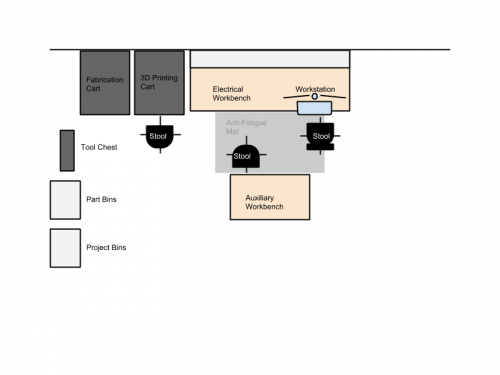
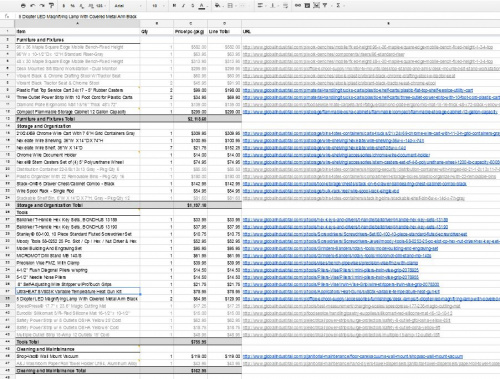
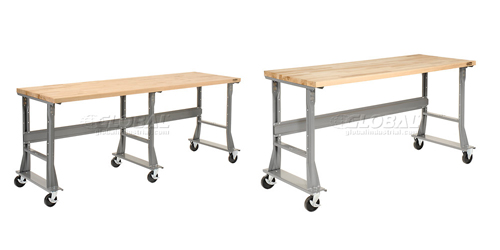
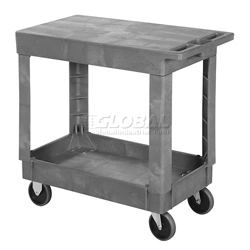
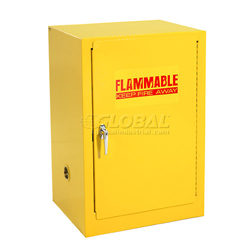
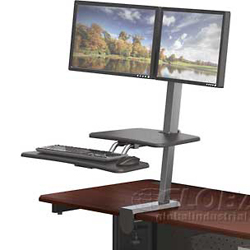


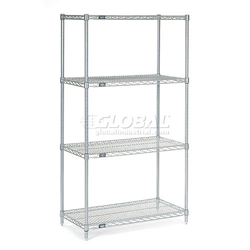

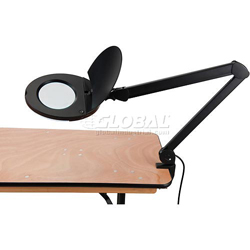







Nick, am I asking too much if we fit a car battery on the 3D Printing Cart and every once in a while you wear a cape and cart from department to department. Printing tiny trinkets for us?
I'm guessing "[Picture of a stack of Industrial Supply Catalogs]" was meant to be a picture of, well, industrial supply catalogs.
Fun reading the article :)
Links to some of these products would have been a nice addition. I had to search online to find the global supply website and then search individually for items shown in the write up. I not only have an electronics workspace, but a nearly complete wood shop in my basement. Getting those organized is something I have to continually work on and the items mentioned above may improve that. Great write up otherwise.
I like the cooking show concept for your workbenches. If you really will be doing a lot of filming you should consider going all the way and adding a cooking show mirror above the bench. It is a large mirror (roughly the size of the bench) mounted directly above the bench and angled so that a camera placed in front of the bench can look through the mirror to get a top down view of the workbench and your hands. See the picture here http://glasslessmirror.com/gallery13
I definitely had an epiphany moment when I first saw this on one of the sets in my college's media department.
Could you share the a view only version of your spreadsheet?
I'm using Stanley professional organizer (~$12 per). removable compartments and pass the 'briefcase test' (yes you can hold them sideways with small parts).
I do need to get around to building a shelving unit for them though.
Great series, thanks!
Please do write a followup in three months and tell us what you've changed and what you wish you'd done differently.
Those plastic organisers look very similar to the ones we get here in australia under the brand "Tactix". After seeing the sortimo rack in the video I think I might have to make one. The trays are $12 each from a local hardware store so it's quite do-able. Damn you sparkfun....yet another project to add to the list!
Sounds like an awesome workspace. Can't wait to see pics when it's ready to go! I'm looking forward to more awesome product videos.
Pictures??